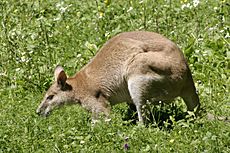Diprotodont facts for kids
Quick facts for kids DiprotodontiaTemporal range: Oligocene – Recent
|
|
|---|---|
 |
|
| A diprotodont, the agile wallaby (Macropus agilis) | |
| Scientific classification | |
| Kingdom: | |
| Phylum: | |
| Class: | |
| Infraclass: | |
| Order: |
Diprotodontia
Owen, 1866
|
| Suborders | |
The Diprotodontia is a large group of about 120 different kinds of marsupial mammals. These animals mostly live in Australasia, which includes Australia and nearby islands. This amazing group includes many well-known animals like kangaroos, wallabies, possums, the koala, and wombats.
Long ago, there were even bigger members of this group that are now extinct. These include the giant Diprotodon family, which were huge, and Thylacoleo, sometimes called the "marsupial lion".
Contents
What are Diprotodonts?
Diprotodonts are special because of their teeth. The name "Diprotodontia" means "two front teeth". These animals have two large, strong lower front teeth that stick out. These teeth are perfect for cutting plants, as most diprotodonts are herbivores (plant-eaters).
Most diprotodonts also have something called syndactyly. This means their second and third toes on their back feet are joined together. They use these fused toes for grooming their fur.
Types of Diprotodonts
Scientists divide the Diprotodontia into smaller groups called suborders. These suborders help us understand how different diprotodonts are related to each other.
Vombatiformes: Koalas and Wombats
This suborder includes some of Australia's most famous animals.
- The Koala is a well-known tree-dwelling marsupial. There is only one species of koala left today.
- Wombats are strong, burrowing animals. There are three species of wombats.
- This group also includes the extinct giant Diprotodon family. These were the largest marsupials ever!
Phalangeriformes: Possums and Gliders
This suborder is full of amazing tree-dwelling marsupials. Many of them are active at night.
- Brushtail possums and cuscuses are part of the Phalangeridae family. They are common in Australia.
- Pygmy possums are tiny possums from the Burramyidae family.
- The Honey possum is a unique animal that feeds on nectar and pollen.
- Gliders are also in this group, like the Sugar glider and Yellow-bellied glider. They have special flaps of skin that let them glide between trees.
- Ringtailed possums and their relatives are known for their long, prehensile tails.
- The Feathertail glider and Feather-tailed possum are tiny, agile creatures.
Macropodiformes: Kangaroos, Wallabies, and Rat-Kangaroos
This suborder includes the famous hopping marsupials.
- Macropodidae is the family of kangaroos and wallabies. They are known for their powerful hind legs and long tails.
- Bettongs, potaroos, and rat-kangaroos are smaller relatives of kangaroos. They are part of the Potoroidae family.
- The Musky rat-kangaroo is a unique animal that looks a bit like a rat and a kangaroo. It's the only living member of its family, Hypsiprymnodontidae.
The symbol † next to a name means that family, genus, or species is extinct.
Images for kids
-
The prominent mandibular central incisors characteristic of the diprotodonts are evident in this Kangaroo Island western grey kangaroo (Macropus fuliginosus fuliginosus)
See also
 In Spanish: Diprotodontos para niños
In Spanish: Diprotodontos para niños


